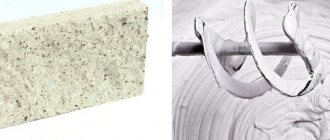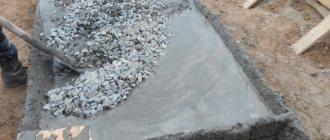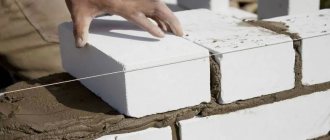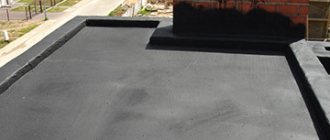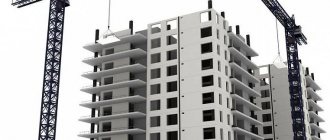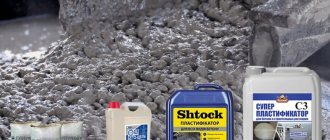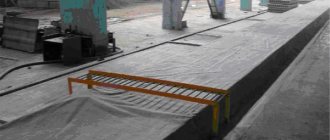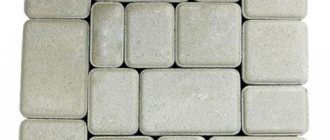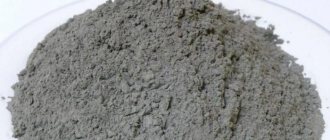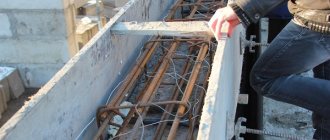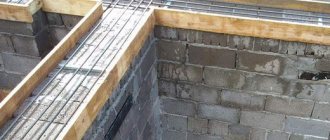Today, the use of cement is quite widespread - despite the emergence of new building materials, concrete based on a cement binder is still considered the most popular, universal and preferred option in many cases. Cement is a powdery substance that belongs to the inorganic class.
Cement is produced by grinding clinker, which, in turn, is obtained by firing clay and lime taken in certain proportions at high temperatures. Various minerals, plasticizers can be added to the powder to improve properties, etc. Cement is used as a binder when mixing concrete solutions of various types and purposes.
The main function of cement is high-quality fastening of structural elements of created structures and buildings being erected. Concrete mortars are used for pouring floors and various structural elements, monolithic construction, production of certain products, etc.
How any type of cement works:
- When mixed with water it turns into a viscous paste.
- The color changes from light gray to dark.
- Concrete quickly gains hardness in a humid and warm air environment.
The mixture gains strength within 28 days (usually) and gradually turns into an artificial stone with very high strength and durability characteristics. The properties of cement can be different and depend on a lot of factors: the type of binder itself, the presence of additives, features and conditions of use, compliance with mixing and laying technology.
Key indicators that are taken into account when choosing cement:
- Strength
- indicated by a brand and the letter M (the higher the number next to it, the higher the strength: for example, M400 indicates that the stone can withstand a load of 400 kg/cm2). It is also calculated in classes (the letter B and next to it a two-digit number that displays the load that the material can withstand, in MPa).
- Frost resistance
– an important characteristic, calculated in the number of freezing/thawing cycles.
- Corrosion resistance
– the ability to withstand the negative influence of the environment. The most durable pozzolanic cement, it is used for the construction of underground/underwater objects.
- Water resistance
– the ability to set in water, as well as withstand exposure to water and moisture if necessary.
- Sulfate resistance
– the ability to withstand the effects of water with sulfate ions, which is important when constructing hydraulic structures that come into contact with salt water.
- Grinding fineness
– influences the hardening period and strength. The finer the powder is ground, the stronger the concrete will be.
Additional properties can be provided by special additives in the powder, the volume of which is always indicated by the manufacturer on the packaging in the labeling and description.
General information
Cement (in Latin caementum), translated as “broken stone” or “crushed stone”. You get it like this:
- Cement is prepared from sludge, the raw materials for which are two main components - 25% clay and 75% ground limestone.
- Next, clinker is formed, for which the finished slurry is fired at a temperature of +1450…+1480 °
C. - The resulting solid mass (clinker) is crushed into a gray powder, to which mineral additives and gypsum are then added.
As a result, an artificially created building material is born, which, interacting with water and other liquids, turns into a plastic substance, and when hardened, forms a stone-like body.
Important! The ability of cement to gain strength when interacting with liquids is unique, and this fundamentally distinguishes this material from other cementitious materials, such as gypsum or air lime, which harden only in air.
What is cement clinker
Clinker is the material that appears after the first stage of cement production. A mixture of limestone and clay is fired in a special furnace at temperatures above 1000 degrees. The result is a granular semi-finished product.
The properties of the finished clinker are determined by the heating technology, the grinding and cooling method, the composition of the raw materials and the addition of additives.
Clinker necessarily contains four elements in certain proportions: at least 52% alite, 14-31% belite, 4-11% aluminate, 5-15% aluminoferrite.
In addition to making cement, clinker is used for lining artificial reservoirs and furnaces, and decorating building facades. It is used as porcelain stoneware for interior decoration. The material can withstand high humidity and also has good thermal insulation properties.
Cement composition
It should be noted that the composition of cement can vary significantly, both across countries and across regions within one country. This is influenced by the presence of mineral deposits that supply components for the manufacture of such material. Here are a few possible compositions:
- various clays, incl. loess-like loams and clay shale;
- limestone, chalk, marl and other carbonate rocks;
- minerals: silicas and aluminas, asparite and fluorite, fluorspar and phosphogypsum used as additives.
Receipt history
The need for a binding material appeared along with the first “construction” attempts. In the beginning and for a long time, clay played the role of a binder. It was not durable.
The ancient Greeks and Romans noticed that lime could also hold materials together. The Romans, who received volcanic ash from Vesuvius, began to add the latter to the lime mixture. The solution became much stronger.
Material similar to modern cement mixtures was obtained through experiments only in the 19th century. Now there are several types of cements, differing in characteristics and purpose.
Properties of cement
Different combinations of components provide very different properties of a given material. Some of them should pay close attention.
- Strength. This indicator depends on the presence of crushed slag or gypsum in the composition, and is responsible for the bearing capacity of products made from cement. By the way, it is the strength that determines the brand of cement sold.
- Frost resistance. The ability of cement to withstand periods of freezing and thawing without loss is determined by the addition of various modifying additives to the composition.
- Water resistance. This is an indicator of the setting speed of cement. The possibility of sealing seams and joints located in a humid environment depends on it;
- Corrosion resistance. This indicator indicates the ability of cement to withstand environmental influences. Cements with the highest corrosion resistance are used for the construction of underground and underwater objects.
- Sulfate resistance. This property of cement indicates its ability to withstand water in which sulfate ions are present. This indicator is important in the construction of marine and oceanic structures that come into contact with salt water.
- Grinding fineness. This characteristic of cement also indicates the strength of the material. The finer the grind, the stronger the concrete will be.
Preparation of cement mixtures
Cement is a material that is obtained in a process divided into two main stages:
- obtaining clinker; limestone is crushed into small pieces and mixed with clay (ratio - approximately 3:1); then this mass is sintered at a temperature of 1400-1500 °C;
- turning clinker into powder; At this stage, the clinker is mixed with gypsum and other additives, and then crushed to a fine powder.
This is a rough production diagram. Each case has its own manufacturing features - types and quantities of additives, firing temperature, filler fraction, etc.
Types of cement
Due to the variety of included components, manufacturers produce a variety of types of cements, which differ in properties, and therefore in scope. Let's look at the most popular types:
1. (PC). This is one of the most common types of cement, which is widely used in private and industrial construction, and is also used for finishing work. It can be called a universal material. Such cement is produced without additives (D0), and can be of the following grades: M400 and M500, M550, and also M600.
2. Colored and white (BC). These types differ in color, because they contain organic or mineral dyes. This feature allows the use of cement-based solutions for decorative finishing of interiors and facades of buildings. In addition, colored cement is used in the production of artificial stone and various sculptural compositions.
Its advantages include resistance to precipitation and ultraviolet radiation. Such cement does not deteriorate, fade or turn yellow even over the years. In addition, it hardens much faster than Portland cement.
3. Rapid hardening (BTC). From the name it becomes obvious that this material has the shortest curing time. In addition, it is extremely frost-resistant. This feature allows construction work to be carried out in a short time and at sub-zero temperatures. Cement grades M400 and M500 are produced.
4. Expanding. Produced with the addition of gypsum. This material is used in cases where they want to minimize possible shrinkage of the future structure. Hardening and getting rid of moisture, such cement expands, thereby compensating for shrinkage.
5. Straining. Produced with the addition of aluminates. The presence of this component allows us to obtain one of the most durable and frost-resistant cements with increased requirements for waterproofing. It is not surprising that such material is used for the production of critical reinforced concrete structures, for example, bridge structures and high-rise buildings.
By the way, as it gains strength, such material expands, filling all existing voids and joints, cracks and niches. Not every type of cement can boast of this feature.
6. Aluminous (AC). This material is characterized by an increased speed of hardening, as well as high hardness and frost resistance. This cement is indispensable for emergency work in conditions of extremely low temperatures.
In addition, aluminous cement has two subtypes:
— Gypsum-alumina cement – used to produce non-shrinkage waterproof concrete;
— High-alumina cement - heat-resistant concrete is produced from it, used for work in environments with elevated temperatures.
7. Waterproof Expandable (WRC). The type in question is highly resistant to moisture, and therefore is successfully used for the construction of concrete structures in wet conditions, for example, the foundations of houses in swampy areas.
8. Hydrophobic (HF). In terms of ability to repel moisture, hydrophobic cement is 5 times superior to waterproof cement. Thanks to this property, the material is used for the construction of swimming pools and other hydraulic structures that require direct contact with water.
9. Phosphate. When producing this material, orthophosphoric acid is added to it, as well as some oxides (copper, magnesium and titanium). The presence of such additives significantly increases the impact strength of cement, due to which it gains the ability to withstand impacts and can be applied to metal surfaces.
10. Sulfate-resistant (SS). It is used for the construction of hydraulic structures, but only those that do not come into contact with river and groundwater. On sale you can find sulfate-resistant cement of the M400 and M500 brands.
11. Slag (SPC). The addition of slag can seriously reduce the cost of the material, but at the same time prevent its strength from weakening. It is not without reason that this cement is used for the construction of underground structures. The disadvantages of such mixtures include their long setting and drying time. Available in the following brands: M300, M400 and M500.
12. Backfilling. This is a specific cement that is used in the gas and oil industries.
What is cement - description and technical characteristics
Dry cement looks like a fine powder, which, when mixed with liquid, turns into a plastic mass. In this form, the material can take on any form under human influence. After prolonged contact with air, the mass hardens to a solid, stone state.
Mixtures are usually divided according to the following criteria:
- Purpose.
- The time it takes for the solution to set.
- Type of base material (clinker).
- Solidification rates.
- Substances included in the composition.
- Strength indicators.
The main technical characteristics of the material include:
- Frost resistance. How many times can a material be frozen and thawed without losing its strength?
- Strength. Check by applying mechanical pressure to a hardened sample. Depending on the rate of destruction, cement is assigned one grade or another.
- The period during which the material sets. Important when carrying out work in the cold season.
History of appearance and scope of use
Cement replaced binder mixtures that hardened in air - gypsum and limestone. These materials had low water resistance and quickly deteriorated under the influence of external factors. They tried to increase the strength of air binders by adding finely ground baked clay to them.
It is known exactly when cement was invented - in 1824. Then modern Portland cement appeared, so named because of the English island of Portland, consisting of limestone rocks. After adding small stones, sand and water to Portland cement, the solution could be used as concrete. It withstood compressive loads well, but did not perform well in tension. A few decades later, metal reinforcement began to be used to strengthen cement structures.
Depending on the type of additives and physical properties, cement is used in different fields:
- production of sculptures or parts of facades,
- decorative coating,
- creating structures that are in constant contact with water, acids or underground.
Some brands of solution are used for emergency work in low temperature conditions.
Application area
Cement is the main component of cement-sand and concrete mortar, due to which it is used in the following structures:
— Construction industry: production of monolithic and reinforced concrete structures necessary for the industrial construction of buildings and engineering structures (public buildings, multi-storey buildings, bridges, dams, etc.);
— Private construction: construction of the foundation of a private house, finishing work, construction of fences and foundations for them;
— Road industrial construction: construction of fender structures, runways, port berths, etc.
— Structures operating in complex and aggressive environments: bridge supports and all kinds of their own, installed in an environment with a high level of acids, in salt water or in conditions of repeated freezing/thawing.
— Extractive industry: strengthening of structures, as well as plugging of oil and gas wells.
What is the difference between cement and concrete?
Cement is a dry mixture that is used specifically for preparing concrete mortar. Concrete is a hardened artificial stone consisting of cement, water and fillers. Gravel, sand, screenings, slag, expanded clay and other materials are usually used as fillers. Until it hardens, concrete is a mobile concrete mixture.
Cement is used not only in construction and repair work. If you need to make something solid and strong, you cannot do without cement.
Cement brands
When deciding to purchase cement, it is important to learn how to navigate the brands of this material.
First of all, the composition of the incoming components is indicated in Roman numerals:
— CEM I is pure Portland cement, practically free of additives (no more than 5% of the total mass of cement powder). This material is characterized by the highest hardening speed, due to which concrete gains 50% strength literally a day after pouring. Its working strength is 32.5 MPa.
— CEM II – Portland cement with additives from 6 to 35%. It hardens a little slower, and all due to the presence of additional elements in the composition.
— CEM III is Portland slag cement, which has a normal hardening rate and a strength of 32.5 MPa. The presence of additives in this material in the region of 35-65% noticeably slows down the process of setting the mixture, however, the presence of granulated blast furnace slag compensates for the rate of hardening.
— CEM IV – pozzolanic cement. It contains 21-35% additives, which means it can also boast a normal hardening speed. In addition to pozzolans (P), its composition includes fly ash (Z) and microsilica (M or MK). In terms of strength, it is not inferior to other types - 32.5 MPa.
— CEM V is a composite cement with a good hardening rate and a strength of 32.5 MPa. Among the additives it contains 11-30% blast furnace slag, as well as 110-30% fly ash.
Important! The presence of additives in cement is indicated by the letter D, as well as the number indicated after it. For example, D0, D5 or D20.
After the components are indicated in the labeling, the type of additive appears:
- I – limestone;
- P - pozzolans;
- Ш – slag (essentially a waste product from metallurgical production);
- W – fly ash (essentially, waste from energy enterprises);
- M, MK – microsilica.
Then there are the strength characteristics of the material. The numbers indicate the strength indicator that the material reaches 28 days after pouring (the indicator varies from 22.5 to 52.5). Today this indicator is designated by the compressive strength class, but previously it was characterized by the brand.
- Strength 22.5 - the ability of cement to withstand pressure of 22.5 MPa (previously designated as M300);
- Strength 32.5 – the ability of cement to withstand pressure of 32.5 MPa (previously designated as M400). This cement is the most popular in private construction, and all thanks to the best price-quality ratio;
- Strength 42.5 - the ability of cement to withstand pressure of 42.5 MPa (previously designated as M500);
- Strength 52.5 – the ability of cement to withstand pressure of 52.5 MPa (previously designated as M600).
The letter indicates the strength indicator that the cement reaches 7 days after pouring:
• B - fast-hardening; • N—normally hardening.
For clarity, we give an example of the designation of cement according to GOST 10178-85:
PC 400-D0-B GOST10178-85. This is a fast-hardening Portland cement that does not contain mineral additives and has a strength of M400.
This marking is outdated, and therefore today on bags of cement you can see another, modern designation in accordance with GOST 31108-2003:
Portland cement CEM I 32.5N GOST 31108-2003. Normally hardening Portland cement containing 5% additives and having a strength of 32.5 MPa (corresponding to grade M400).
White
The unique snow-white color, weather resistance and other characteristics make white cement in demand for solving a wide range of problems, in particular decorative ones.
What is it, composition
White cement is a mixture of low-iron clinker, crushed lime, kaolin, chlorinated salt and gypsum powder. with a low content of iron, manganese and chromium are used as raw materials , i.e. elements that cause products to turn standard gray. Their small quantity and the addition of special pigments make it possible to obtain a powdery mixture of a light , almost white color, with which it is possible to create solutions with pure colors.
White cement M500 D0 3 kg. Photo Petrovich
After hardening, the mixture turns into a high-strength material, which is divided into grades - from M400 to M700. The number shows the load that the material can withstand , in kg/cc. It is necessary to pay attention to other symbols in the labeling. The letter “N” demonstrates the rapid setting of the mixture, which reduces the time required to complete construction work. An important parameter is the amount of impurities, denoted by the letter “D”, measured as a percentage. The maximum allowable value is 20%. The “D0” marking demonstrates the absence of impurities.
Technology for the production of white products
Clinker for cement production is obtained from raw materials with a minimum content of coloring substances, i.e. oxides of Fe, Mn, Cr. The main components of clinker are white limestone, kaolin, marble. The production technology has minor differences from the manufacturing process of gray building material. But there are a number of features that make the technological process somewhat more complicated. As a result, production involves the following steps:
Extraction of raw materials , their crushing and processing in screens in accordance with dry or wet technology. During this stage, accidentally introduced “coloring” components are removed from the raw material.
The firing of raw materials is carried out in rotary kilns operating on ash-free fuel, i.e. on gas or fuel oil, which avoids contamination of products with coal ash and soot. During the formation of clinker, iron acts as a flux, and the almost complete absence of iron oxide requires an increase in temperature. The liquid phase of clinker is formed at temperatures in the kiln up to 1650 degrees, characterized by increased viscosity and a small temperature difference between melting and hardening.
Clinker grinding. A well-functioning production mechanism eliminates contamination of the mixture with iron particles during the grinding process. Therefore, instead of conventional ball mills, equipment with stone or ceramic elements (linings) is used for grinding, using rather inefficient processing using balls made of silicon, nickel and molybdenum alloys. As a result, the cost of grinding is higher, which, combined with more expensive raw materials, makes the white material quite expensive.
Clinker bleaching. The meaning of the process is to reduce the iron oxide Fe2O3 present in the clinker to Fe3O4, the first gives the mixture a greenish tint, and the second has low coloring ability.
The remaining stages of white cement production: clinker grinding, laboratory testing of products and packaging of finished products are similar to the processes performed when producing gray building materials.
Features and Benefits
It is more logical to consider the characteristics of white cement in comparison with the parameters of a gray binder for general purpose. As a result, white cement has:
- increased frost resistance , finished structures can withstand over 100 freeze-thaw cycles;
- increased strength , which is provided by finer grinding, which also promotes better adhesion to other components of concrete solutions;
- high level of moisture resistance , which allows the use of white cement products in all weather conditions;
- minimum period of setting and strength gain , within 15 hours after pouring the solution gains 65-70% of brand strength, final hardening occurs within a period of up to 72 hours;
- excellent aesthetic appearance , which is especially highly appreciated by designers.
White cement. Baucentr Photos
In addition, it is possible to highlight other advantages:
- does not hide the color of coloring pigments;
- allows you to add less “chemicals” to the composition, which ensures higher environmental friendliness;
- sulfate-resistant , the composition contains less than 5% alkalis, as a result the material is resistant to acids in groundwater and sediments.
The main consumer characteristic is the high coefficient of light reflection, which provides an excellent decorative and aesthetic appearance of finished products and structures. The degree of light reflection (whiteness) regulates the composition of the clinker. In accordance with regulatory documents, three grades are distinguished depending on the ability to reflect light: 1st, 80% - minimum reflectance; 2nd - 75% and 3rd - 70%. The grade is indicated in the markings on the packaging or is present in the accompanying documents.
The only drawback of white cement, both in comparison with its standard counterpart and in general, is its high cost. Therefore, despite the wide possibilities for use, white cement is not used as often as it could be.
Application area
White cement is not a final product, but is a raw material component used in the production of various types of building materials . As a result, the main consumers on the Russian market are manufacturers of dry mixes: putties and plasters, colored masonry and self-leveling mortars. The material is used by manufacturers of concrete products : building blocks, artificial stone, facing bricks, paving stones and curb stones, floor slabs, landscape design elements.
The high coefficient of light reflection and the optimal granulometric composition of white cement make it an ideal basis for creating high-quality concrete surfaces. They are more durable than structures made of gray cement and withstand environmental influences for a long time. An important positive feature of the products is the absence of the need for subsequent processing : painting or plastering.
Concrete products based on white cement. Photo by LafargeHolcim
The advantage of white concrete surfaces is the ease of maintaining them in their original form, because... they do not change color or crack, they are easy to care for, and dirt can be removed with water. The surface of any structure based on white cement does not darken in the rain; gray loses up to 70% of its reflective ability, white - less than 5%. This property allows the use of cement in the production of not only curbstones, but also dividing strips on highways and airfield pavements. White cement is also used:
- in the production of reinforced concrete products: paving slabs (it’s possible to make cement tiles with your own hands), stair steps, facing stones, etc.;
- in the production of decorative products: sculptures, items for decorating facades, balusters, railings and fences of various types, flowerpots for plants and much more;
- as a basis for cement-lime mortars, self-leveling floors, adhesives, grouts and other dry construction mixtures;
- in the production of finishing products and compositions.
Types: in bags 50 kg. and so on
White cement is sold mainly in bags, most often weighing 50 kg. Construction material is available for sale in big bags weighing 1000 kg. and sling bags of similar weight. Products are practically not supplied in bulk.
M500, M600 and other brands
White, like gray, cement is divided into separate grades:
- M400 is the weakest, has low sulfate resistance and shrinkage, is rarely used in construction and finishing, the rate of hardening and deformation during shrinkage are at an average level;
- M500 is the most popular brand, high demand provides high strength, good frost and weather resistance, average sulfate resistance and low shrinkage, and has the best price-quality ratio. The hardening rate is average, the deformation during shrinkage is low.
- M600 - the grade practically does not shrink, it is distinguished by high frost resistance and strength, hardens quickly, is characterized by low sulfate resistance, and is sold at high prices.
- M700 is the most expensive brand, but has the best performance in accordance with several characteristics: shrinkage, strength, etc.
Varieties
There are three grades of white cement, the classification is done according to the reflectance i.e. for decorative reasons:
- the first with a reflection coefficient of more than 80%, i.e. almost snow-white cement;
- second – the reflection coefficient does not exceed 75%., i.e. white, but not snow-white;
- third – 68% reflection.
Manufacturers indicate the variety on the packaging. This indicator is one of the main ones when choosing the optimal option for achieving your goals. Because it affects the cost and appearance of products in the manufacture of which cement is used. It is possible to find “Super White” cement on sale, which has a reflectivity of about 90% and is marked M600.
Market, producers
The Russian white cement market is represented mainly by imported products. In the Russian Federation, only one specializes in the production of white cement (the former Shchurovsky Cement). Some of the world's leading enterprises provide Russian consumers with their own high-quality products: Cimsa and Adana (both from Turkey), Aalborg white (Denmark), Dyckerhoff (Germany).
Turkish: Adana and more
Türkiye is one of the largest suppliers of white cement to the Russian market. Today it is possible to find and buy products from several Turkish manufacturers : Cimsa, Akcansa, Adana Cement, Oyak Cement Group. In 2004, the government of the Turkish Republic tightened quality standards for cement produced (both gray and white), which increased the competitiveness of products in the world market. Quality control methods were tightened, the list of mineral additives used was expanded, and the number of types of cement produced was increased.
To improve quality, kaolin, granulated furnace slag, specially treated limestone and shale, silica mist, and evaporating silica ash to their products In addition, the products of each brand have their own advantages. White cement of the Adana brand is produced on the basis of low-iron clinker; the main components in the composition are kaolin, limestone or chalk. It has gained popularity due to its unique properties, which are unique only to products of this brand: mega-white, does not affect the color of other building materials, resistance to changes in atmospheric pressure. Cimsa brand cement is distinguished by its high degree of whiteness, reaching 85%. The production of superwhite cement is facilitated by a specific production technology. Cimsa products are in demand among consumers in Europe and the CIS countries.
Advantages
Turkish-made cement, regardless of the brand, has a whole range of advantages and disadvantages, in particular over building materials from Holcim Rus:
- The low price is due to the production method. Turkish white cement is produced using an economical dry method, while the Russian manufacturer uses energy-intensive “wet” technology.
- High reflective ability , expanding the scope of application: arrangement of designer floor coverings, general construction and finishing works, production of SSS and facing tiles, production of paving slabs.
- The high degree of “whiteness” gives Turkish cement an advantage in the production of imitation wild stone and terrisite floor tiles.
Aalborg White Cement
The Danish company is one of the leaders in the global market. The products are of high quality; production is carried out using innovative technologies. The main advantages are low alkali content, high reflective qualities, even whiteness, as a result, it has a wide range of applications.
Holcim
Swiss white cement, despite its foreign origin, is produced in Russia. Used for the production of dry mixtures and the production of durable monolithic supports. It has the following positive qualities: super strength, minimal consumption in the production of concrete solutions, increased heat generation during hydration, and harmoniously combines with various additives. Experts note the durability of structures that were built using Holsim products.
Small architectural forms based on white Holcim cement. Photo by LafargeHolcim
Others
The Egyptian company White Portland Cement is located near the deposit where the purest raw materials for the production of white cement are mined. The quality control system for raw materials and automatic regulation of production processes ensure that products meet high standards. To prevent discoloration of the building material, the manufacturer has achieved a low iron content in the composition, while at the same time ensuring the required PH level. The low alumina content prevents early setting of the solution and the appearance of cracks during shrinkage.
Dyckerhoff white cement is produced from raw materials with minimal iron content. As a result, the material is easier to color by adding colored pigments than gray cement, so it is excellent for the production of white and colored products: artificial stone, high-quality plasters, precast concrete elements, which have a pleasant and rich color.
Recommendations for working with cement, rules for preparing mixtures
When using white cement to prepare mixtures at home, you must follow the instructions presented on the packaging. White cement is a special type, so working with it must be carried out in compliance with certain rules :
Tools, equipment, pouring molds and other items that will come into contact with the cement mixture must be absolutely clean.
concrete mixer. Baucentr Photos
Fillers and water must also be clean and free of impurities that can change the color of the solution. Therefore, ordinary sand is not suitable, it contains clay impurities, it is necessary to choose purified quartz sand with a fraction size of 0.1 to 1 mm. or sifted and washed hand sand from 0.5 to 2 mm. or marble flour 0.1-1.5 mm.
If reinforcement of the structure with steel elements is required, then they must be pre -treated with anti-corrosion and covered (coated) with a layer of concrete several millimeters thick. Metal reinforcing elements must lie at a depth of at least 3 cm from the surface.
A colored solution based on white cement should contain no more than 5% coloring pigment .
You should not add an increased amount of sand , because this reduces the plasticity and “dampens” the color qualities of the solution.
The preparation of solutions with white cement is carried out similarly to the technology for preparing mixtures with gray material . Dry components: cement, sand and, if necessary, crushed stone are poured into a clean and dry container, standard proportions 1: 3: 3. The components are thoroughly mixed until a homogeneous consistency is obtained. Add a small amount of water and stir again. Add water until the solution reaches a creamy consistency. The amount of water most often does not exceed 15%.
To maintain the mortar after removing the formwork, use only clean water.
For white concrete mortars, you need to use plasticizing and air-entraining additives , and, if necessary, retarders, but only those that do not cause coloration of the mixture.
Consumption rates
The consumption rate is determined by the specific brand of building material. For example, to create an M150 mortar from M400 cement, 225 kilograms of powder are required. When making a solution, it is necessary to comply with building regulations, then the contractor will definitely receive a high-quality mixture with the necessary characteristics. When doing the work yourself, it is important to remember that the material sets in 45 minutes, complete drying takes 12-16 hours.
How to choose
When choosing, you need to study the product characteristics:
First of all, you need to pay attention to the brand of the product , it should be at least M400-500. The density of white cement is slightly lower compared to traditional gray cement. And despite the assurances of manufacturers about the excellent strength characteristics of white cement, which are similar or even superior to those of gray, it is recommended to choose a material of a higher grade.
Secondly, you need to pay attention to the manufacturer and supplier . The Russian market offers products from leading enterprises, so the choice must be made depending on the availability of products for purchase. In this case, you need to purchase building materials from reliable suppliers.
Thirdly, cement differs in whiteness , which may come as a surprise during the process of preparing the solution. In addition, to obtain a repeatable color, you need to keep the proportions constant when mixing each batch of components.
Fourthly, the quality of cement depends on storage conditions. The building material must be stored in dry areas, away from moisture, otherwise it will harden.
How to choose quality cement
To purchase suitable, and most importantly, high-quality cement, you should listen to the advice of professionals. The algorithm of actions should be as follows:
1. Decide on the manufacturer. Practice shows that cement of domestic brands is cheaper. In addition, its manufacturers are located within the country, making it easier to return low-quality material. But when you decide to purchase cement from a foreign brand, first of all pay attention to the expiration date. Due to the high cost, such goods are often left in warehouses, as a result of which their shelf life expires. At the same time, the quality of fresh imported cement is excellent, which is noted by all professionals.
2. Estimate the expiration date. Even if the expiration date has not yet expired, but the bags of cement have already become hard, you should refuse to buy them. The fact is that the shelf life of some brands of cement does not exceed 2 months. And stale cement rapidly wastes its valuable qualities. Pay special attention to the product when purchasing in bulk. Unscrupulous sellers may add bags of stale or even expired material to fresh cement.
3. Arm yourself with reviews from the Internet. Before purchasing cement, it would be a good idea to read reviews from users who have already used this material in construction. Statements from Internet users can significantly influence your choice.
4. Feel the packaging. The cement bag should consist of 3 or 4 layers. In addition to the designation of cement and the indication of the manufacturer's company, it must contain contact information of the company that produced this product.
5. Understand the brand of cement. Choosing a brand of material should not cause difficulties. Everything is simple here: the higher the grade of cement, the more durable the structure created on its basis will be. The speed of hardening of the material will be indicated by the letters N (normal-hardening) or B (fast-hardening) on the cement packaging.
However, as the grade of cement increases, its price also increases. Material sold not in bags, but in bulk, is noticeably cheaper, but such cement is easier to falsify, and therefore when purchasing such material, you risk encountering low-quality cement.
Some useful tips for using cement
In order for a concrete solution made from cement to meet all requirements and be suitable for creating strong, reliable, durable structures and products, it is necessary to remember some rules.
Useful recommendations for the use of cement:
- The binder should be stored for no more than 3 months and only in a place protected from moisture and wind. It is best on special pallets, in factory bags.
- The correct recipe should be found immediately and components can only be added at the stage of mixing the dry ingredients. When the cement is mixed with water, it is no longer possible to add dry components. Therefore, water is initially poured a little at a time, achieving the desired consistency.
- An open bag of cement can be stored for no more than 1 week in low humidity conditions and a maximum of 1 day in high humidity conditions.
- Crumpled cement cannot be used - some advise breaking up the stones and using it as a regular binder, but the reaction has already passed and the chemical formula cannot be returned. Such cement can be used only in the form of a filler, and then in a volume not exceeding a third of the total volume of fillers.
- When mixing concrete, you must strictly follow the proportions; any deviation will reduce the properties.
- In cold weather, you need to use special frost-resistant cement. In extreme heat, it is better not to work or to organize careful care of the hardening concrete.
- More cement or too high a grade does not mean higher strength. You should always focus on standards and use the brand that is suitable for a specific type of work. If you choose a low-grade binder, concrete will not provide the required characteristics; if you choose a high-grade binder, the costs will not be justified due to its irrelevant properties.
Popular cement manufacturers
• Eurocement group . This domestic company is a real leader in the production and sale of cement in Russia. And how could it be otherwise, if the company’s products meet all international standards, and at the same time boasts some of the lowest prices. Reviews speak of the high quality and excellent resistance of cement to low temperatures and water.
• "Holcim" . The Swiss company has firmly established itself in our market, not only due to its high quality and wide range of applications, but also due to the amazing whiteness of its products. Such cement is prepared from special clinker with minimal iron presence. The only drawback of this manufacturer is that it is quite difficult to find such cement on sale.
• "Hercules" . Another domestic brand that is recommended to be purchased for making screeds. Practice shows that such screeds harden quickly and last for decades. It also has an original bag with finger holes, making it easy to carry. This is an environmentally friendly, high-quality product, but it is not without its drawbacks. The price of “Hercules” is quite high, but the shelf life is only 2 months.
• “De Luxe” from Favorit LLC. An excellent product with pronounced adhesive properties and fast hardening, at a fairly attractive price. However, the packaging of such cement is quite large (50 kg bag), and you can work with such material only at temperatures above +5°C.
• "CimSa" . White cement from a Turkish manufacturer is often purchased when carrying out finishing work. Such cement brand M600 has gained particular fame. It provides a perfectly smooth surface, does not crack and is able to protect metal products from corrosion. Its only drawback is the steep price.
• "Adana Cemento" . A young Turkish company recently settled in Russia, but has already won a lot of fans. The cement of this brand is distinguished by its strength and durability, has high aesthetic and decorative properties, which even exceeds established international quality standards. It's good for everything except the price is too high.
• "Rusean" . This company is one of the oldest manufacturers of building materials in Russia, and therefore, having long listened to the needs of customers, produces easy-to-use, but at the same time plastic, strong and weather-resistant cement. It should be noted that its price is slightly higher than that of other domestic manufacturers, but reviews say that the overpayment is worth it.
Now you know exactly which cement is ideal for your planned construction work. Remember that cement is the basis, which means the durability and reliability of the structures you build depends on the right choice.
No. 6. What to look for when choosing cement?
The demand for cement is enormous, which has given rise to the emergence of many unscrupulous manufacturers who often mix additives into cement that greatly reduce the quality of the finished composition. In order not to make a mistake when choosing cement and to buy a really high-quality product, you need to know something about what good cement looks like and what properties it should have:
- cement is sold in bags and in loose form. It is better to take cement in bags, since this way it is protected from external influences, retains its qualities longer, and on the packaging of the bag you can always find out information about the composition, production date, characteristics of the cement and its manufacturer. The bags are usually made of two layers of paper, the inner one protects the cement from getting wet. By the way, the absence of any information on the packaging is also a sign that you may have low-quality material;
- If you buy cement in bulk and it is packaged in bags, then it is better to carefully check the expiration date on each one, since they may sell you stale goods in the bulk. The activity of cement drops several times after 6 months from the date of production;
- check the freshness of cement experimentally. It is enough to hit the bag - the sensation should not resemble hitting a stone. The cement in the corners of the bag hardens first, so it doesn’t hurt to check them either. Naturally, if there is no production date on the packaging at all, then it is better not to buy such a product;
- cement should be stored in dry and well-ventilated areas, otherwise it will quickly turn to stone;
- The color of high-quality cement is gray, more precisely from light gray to dark gray and even greenish. Dark and marshy shades are not allowed. Good cement should crumble in your hand and not crumple into a lump when squeezed;
- The fineness of grinding affects the curing process. The finer the particle fraction, the faster the composition will harden and the higher its price. Too fine a fraction increases water consumption, so ideally it is better to take cement where fractions from 40 to 80 microns are found;
- does not interfere with carrying out assessment of cement composition and characteristics. This is not difficult to do, but you need to prepare sodium bicarbonate water in advance (Borjomi will do) or sodium bicarbonate chloride water. Gas must be released from the water. Next, we use it to knead cement dough and form it into a cake with a diameter of 15 cm. It should be thicker in the center (5 cm), narrower towards the edges (1 cm). High-quality cement should begin to set no later than after 10 minutes, and the thickened part will noticeably heat up. If setting does not occur even within 30 minutes, then you have a composition of low quality.
Types of counterfeit bags using designations that are confusingly similar to the trademarks of Eurocement Group JSC
Colored/decorative
In addition to gray and white, the industry produces cements of various colors . Colored decorative is obtained by grinding white clinker, gypsum and colored pigments , supplemented with special additives. The factory produces products based on Portland cement in white, yellow, green, and black shades of varying intensity. Cement is colored when dyes are added to white clinker. It is made red by the mummy, brown by umber, yellow by ocher, green by chromium oxide, black by soot, blue by ultramarine. To give a different color, pigments are used that can be used at home.
Advantages and disadvantages
The main advantage is high ergonomic characteristics and visual appeal , which ensure active use in the field of design and decoration. The use of colored cement allows you to paint the entire mass of concrete, and not just the surface of finished products and structures, which provides a more pronounced aesthetic effect. However, there are also disadvantages, one of the main ones is that the use of coloring pigments increases shrinkage. The use of low-quality dyes can lead to the appearance of salt deposits on the surface of concrete, which worsens the appearance of the products. In general, the material is of high quality and, accordingly, has wide application possibilities.
Where is it used?
Colored cement is used to create various architectural forms, where it is used in the form of concrete mortars and compositions, whitewash, and used for cladding blocks and panels . Colored cement in the form of solutions is used in the production of a wide range of products:
- paving slabs, paving stones, curbs, garden paths;
- artificial finishing stone for facade decoration;
- street decor: pots, vases, flower beds and other small architectural forms;
- colored plaster;
- cement paints;
- decorative brick and foam block.
Types of dyes, paint, pigments
Cement paint is used to change the natural color of the mortar into the desired one. There are various coloring options. The most popular types of coloring pigments are:
- powdered dry substances;
- special pastes;
- liquid: emulsions and capsules/granules with coloring matter.
SIKA SikaCem 1 Color dye for concrete and mortars 0.5 kg. yellow. Photo by Maxidom
Pigments are subject to certain requirements, non-compliance with which makes the dye for the solution or the surface of the finished product unsuitable for use:
- hiding power - the ability to cover the natural (gray) tone of the material;
- dispersion - distribution of the dye throughout the mixture or monolith;
- low level of oil absorption , the maximum value should be 40-100 units;
- resistance to corrosion, ultraviolet rays, alkalis, temperature changes and other factors;
- long service life.
Paint can be natural, based on materials of natural origin, or synthetic, obtained by processing specific chemicals. There are other types:
- Acid dyes are designed to impart color to hardened concrete; the ready-to-use product penetrates into the monolith to a depth of about 1 mm.
- Acrylic dyes are the most affordable option and provide rich color.
- Dry dyes are applied in a thick layer to fresh concrete.
- Simple dyes are usually made in powder form, but you can make them yourself.
- Color additives introduced into the composition at the preparation stage are available in the form of powder and liquid.
Any pigment for concrete requires mixing with solvents and other special substances that ensure faster drying and make the composition resistant to harmful influences. Water, white spirit, drying oil, and acetone are used as solvents.
Pigments can be produced in factories and at home . In the first case, dyes are made from organic and mineral substances; during the manufacturing process they are enriched with artificial additives. Such substances are distinguished by excellent characteristics and durability. Homemade dyes should be used carefully, because... they don't always give the desired effect.
Making your own dye
Making your own dye requires adherence to technology and proportions. For production you will need dry lime paint of the selected color - 500 g; calcium chloride, used as a surface setting accelerator and as an anti-frost additive - 240 ml; fluff lime - 1.5 kg; laundry soap - 30 g; clean water at room temperature - 6 liters; 3 containers. Lime is poured into a bucket and 5 liters of water are gradually poured in, the components are simultaneously mixed. The dye is combined with water to obtain 1 liter of liquid paint, calcium chloride is added. The soap is crushed and poured with a small amount of hot water. Soap and paint mixture are poured into the lime mortar, everything is mixed and filtered.
Red, black and other dye colors
The color of the mortar or concrete monolith depends on the shade of the pigment and the color of the cement. To obtain a bright and precise shade, choose white cement; for muted colors, gray is suitable. Manufacturers' pigment colors are most often limited to basic shades: yellow, green, red, blue, black. Combining them in the right proportions allows you to obtain secondary shades. The most popular colors for coloring cement are white, yellow, green, red and black.
Staining methods
Coloring concrete during its preparation allows you to obtain the most durable and uniform color. There are several coloring options:
When mixing the solution, add one pigment of the selected color in the volume specified in the instructions. The proportions in this case will be as follows : 1 part cement, 2.5 parts white purified sand, 4 parts washed granotsev, 0.3 parts clean water and color, the amount of which is most often 5-10% by weight of the binder. To obtain high-quality material, uniform mixing of the components is required, so it is recommended to use a concrete mixer . First, sand and gravel are loaded into the concrete mixer, the components are mixed, cement is added, mixed again, dye is added, and mixing is carried out until the mixture acquires a uniform color. Add water in small portions during mixing.
A mixture of different shades is poured into the mold , which allows you to create an original decorative effect.
Several dyes with shades of the same color are added to the mixture, which allows you to create the texture of natural stone.
The inside of the form for pouring concrete is coated with pigment, then the solution is poured.
Applying dye to the finished surface. For painting, you should choose deeply penetrating compounds - up to 5 mm.
